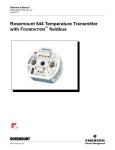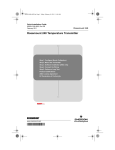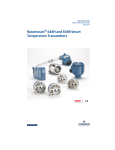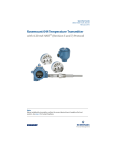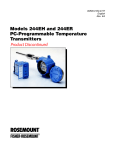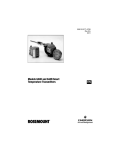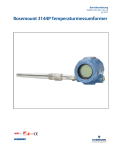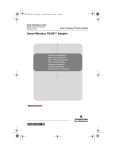Download Emerson Rosemount 644h Installation guide
Transcript
4728_Rev BA.fm Page 1 Wednesday, July 9, 2003 10:25 AM Quick Installation Guide 00825-0100-4728, Rev BA May 2003 Rosemount 644 Rosemount 644H and 644R Smart Temperature Transmitters Start Step 1: Configure (Bench Calibration) Step 2: Set Failure Mode Switch Step 3: Mount the Transmitter Step 4: Connect the Wiring Step 5: Perform a Loop Test Power Up Transmitter Check Process Connections Confirm Configuration End HART® ¢00825-0100-4728[¤ www.rosemount.com 4728_Rev BA.fm Page 2 Wednesday, July 9, 2003 10:25 AM Quick Installation Guide 00825-0100-4728, Rev BA May 2003 Rosemount 644 © 2003 Rosemount Inc. All rights reserved. All marks property of owner. Rosemount Division 8200 Market Boulevard Chanhassen, MN USA 55317 T (US) (800) 999-9307 T (Intnl) (952) 906-8888 F (952) 949-7001 Rosemount Temperature GmbH Frankenstrasse 21 63791 Karlstein Germany T 49 (6188) 992 0 F 49 (6188) 992 112 Emerson Process Management Asia Pacific Private Limited 1 Pandan Crescent Singapore 128461 T (65) 6777 8211 F (65) 6777 0947/65 6777 0743 IMPORTANT NOTICE This installation guide provides basic guidelines for the Rosemount 644. It does not provide instructions for detailed configuration, diagnostics, maintenance, service, troubleshooting, or installation. Refer to the 644 Reference Manual (document number 00809-0100-4728) for more instruction. The manual and this QIG are also available electronically on www.rosemount.com. WARNING Explosions could result in death or serious injury: Installation of this transmitter in an explosive environment must be in accordance with the appropriate local, national, and international standards, codes, and practices. Please review the Product Certifications for any restrictions associated with a safe installation. In an Explosion-Proof/Flame-Proof installation, do not remove the transmitter covers when power is applied to the unit. Process leaks may cause harm or result in death • Install and tighten thermowells or sensors before applying pressure. • Do not remove the thermowell while in operation. Electrical shock can result in death or serious injury • Avoid contact with the leads and terminals. High voltage that may be present on leads can cause electrical shock. 4728_Rev BA.fm Page 3 Wednesday, July 9, 2003 10:25 AM Quick Installation Guide 00825-0100-4728, Rev BA May 2003 Rosemount 644 STEP 1: CONFIGURE (BENCH CALIBRATION) The 644 communicates using the HART Communicator (communication requires a loop resistance between 250 and 1100 ohms. Do not operate when power is below 12 Vdc at the transmitter terminal). Refer to the 644 Reference Manual (document number 00809-0100-4728) and the HART Communicator Reference Manual (document number 00809-0100-4275) for more information. Update the HART Communicator Software The HART Communicator Field Device Revision Dev v6, DD v1 or higher is required for complete functionality. The device will communicate with all previous 644 DD revisions. Perform the following steps to determine if an upgrade is required. 1. Connect the sensor (see the wiring diagram located on the inside of the housing cover). 2. Connect the bench power supply to the power terminals (“+” or “–”). 3. Connect a HART Communicator to the loop across a loop resistor or at the power/signal terminals on the transmitter. 4. The following message will appear if the communicator has a previous version of the device descriptors (DDs). NOTICE: Upgrade the communicator software to access new XMTR functions. Continue with old description? NOTE: If this notice does not appear, the latest DD is installed. If the latest version is not available, the communicator will communicate properly. But, when the transmitter is configured to utilize the advanced features of the transmitter (such as one of the added sensor input types), the user will experience trouble communicating and will be prompted to turn the communicator off. To prevent this from happening, upgrade to the latest DD or answer NO to the question and default to the generic transmitter functionality 4728_Rev BA.fm Page 4 Wednesday, July 9, 2003 10:25 AM Quick Installation Guide 00825-0100-4728, Rev BA May 2003 Rosemount 644 STEP 1 CONTINUED... Figure 1. Connecting a Communicator to a Bench Loop. 644 Head Mount Transmitter 644 Rail Mount Transmitter 250 ≤ RL ≤ 1100 250 ≤ RL ≤ 1100 AMS HART Communicator Power Supply AMS HART Communicator Power Supply Verify Transmitter Configuration From the Home Screen, enter the HART Fast Keys listed below to verify if the transmitter is configured correctly. This table contains the minimum functions required for configuration. Refer to the 644 Reference Manual (document number 00809-0100-4728) for a complete list. Communicator Functions LRV (Lower Range Value) Sensor 1 Setup Sensor Type URV (Upper Range Value) Variable Mapping Verify Callendar Van-Dusen Constants (f applicable) HART Fast Keys 1, 1, 6 1, 3, 2, 1, 2 1, 3, 2, 1, 1 1, 1, 7 1, 3, 1 1, 3, 2, 1, 3 4728_Rev BA.fm Page 5 Wednesday, July 9, 2003 10:25 AM Quick Installation Guide 00825-0100-4728, Rev BA May 2003 Rosemount 644 STEP 1 CONTINUED... Input/Verify Callendar Van-Dusen Constants If sensor matching is being used with this combination of a transmitter and sensor, verify the constants input. 1. At the Home screen, select 1 Device Setup, 3 Configuration, 2 Sensor Config, 1, 1 Sensor 1, 3 Cal Van-Dusen. Set the control loop to manual. Select OK 2. Select Cal Van-Dusen at the Enter Sensor Type prompt. 3. Select the appropriate number of wires at the Enter Sensor Connection prompt. 4. Enter the Ro, Alpha, Beta, and Delta values from the stainless steel tag attached to the special-order sensor. 5. Select OK after you return the control loop to automatic control. STEP 2: SET FAILURE MODE SWITCH 644H (switch on bottom right of electronics module) Without a LCD Display 1. 2. 3. 4. Set the loop to manual (if applicable) and disconnect the power. Remove the electronics housing cover. Set the switch to the desired position. Reattach housing cover. Apply power and set the loop to automatic control. With a LCD Display (644H only) 1. Set the loop to manual (if applicable) and disconnect the power. 2. Remove the electronics housing cover. 3. Snap-off the LCD display straight off. 4. Set the switch to the desired position. 5. Reattach the LCD display and electronics housing cover (consider LCD display orientation – rotate in 90 degree increments). 6. Apply power and set the loop to automatic control. 644R (switch on middle of front panel) 1. Open the front door of the 644R Rail Mount Transmitter 2. Set the switch to the desired position. 4728_Rev BA.fm Page 6 Wednesday, July 9, 2003 10:25 AM Quick Installation Guide 00825-0100-4728, Rev BA May 2003 Rosemount 644 STEP 3: MOUNT THE TRANSMITTER Mount the transmitter at a high point in the conduit run to prevent moisture from draining into the transmitter housing. Typical Connection Head Installation Head Mount Transmitter with DIN Plate Style Sensor 1. Attach the thermowell to the pipe or process container wall. Install and tighten the thermowell before applying process pressure. 2. Verify the transmitter failure mode switch. 3. Assemble the transmitter to the sensor. Push the transmitter mounting screws through the sensor mounting plate and insert the snap rings (optional) into the transmitter mounting screw groove. 4. Wire the sensor to the transmitter (see Step 4:Connect the Wiring). 5. Insert the transmitter-sensor assembly into the connection head. Thread the transmitter mounting screw into the connection head mounting holes. Assemble the extension to the connection head. Insert the assembly into the thermowell. 6. Slip the shielded cable though the cable gland. 7. Attach a cable gland into the shielded cable. 8. Insert the shielded cable leads into the connection head through the cable entry. Connect and tighten the cable gland. 9. Connect the shielded power cable leads to the transmitter power terminals. Avoid contact with sensor leads and sensor connections. 10. Install and tighten the connection head cover. Enclosure covers must be fully engaged to meet explosion-proof requirements. C D E A = 644H Transmitter B = Connection Head C = Thermowell F D = Transmitter Mounting Screws E = Integral Mount Sensor with Flying Leads F = Extension 3144-0433QIG B A 4728_Rev BA.fm Page 7 Wednesday, July 9, 2003 10:25 AM Quick Installation Guide 00825-0100-4728, Rev BA May 2003 Rosemount 644 STEP 3 CONTINUED... Typical Universal Head Installation Head Mount Transmitter with Threaded Sensor 1. Attach the thermowell to the pipe or process container wall. Install and tighten thermowells before applying process pressure. 2. Attach necessary extension nipples and adapters to the thermowell. Seal the nipple and adapter threads with silicone tape. 3. Screw the sensor into the thermowell. Install drain seals if required for severe environments or to satisfy code requirements. 4. Verify the transmitter failure mode switch. 5. Pull the sensor wiring leads through the universal head and transmitter. Mount the transmitter in the universal head by threading the transmitter mounting screws into the universal head mounting holes. 6. Mount the transmitter-sensor assembly into the thermowell. Seal adapter threads with silicone tape. 7. Install conduit for field wiring to the conduit entry of the universal head. Seal conduit threads with silicone tape. 8. Pull the field wiring leads through the conduit into the universal head. Attach the sensor and power leads to the transmitter. Avoid contact with other terminals. 9. Install and tighten the universal head cover. Enclosure covers must be fully engaged to meet explosion-proof requirements. A D B C E A = Threaded Thermowell B = Threaded Style Sensor C = Standard Extension D = Universal Head (transmitter inside) E = Conduit Entry 4728_Rev BA.fm Page 8 Wednesday, July 9, 2003 10:25 AM Quick Installation Guide 00825-0100-4728, Rev BA May 2003 Rosemount 644 STEP 3 CONTINUED... Rail Mount Transmitter and Sensor 1. Attach the transmitter to a suitable rail or panel. 2. Attach the thermowell to the pipe or process container wall. Install and tighten the thermowell, according to plant standards, before applying pressure. 3. Attach the sensor to the connection head and mount the entire assembly to the thermowell. 4. Attach and connect sufficient lengths of sensor lead wire from the connection head to the sensor terminal block. 5. Tighten the connection head cover. Enclosure covers must be fully engaged to meet explosion-proof requirements. 6. Run sensor lead wires from the sensor assembly to the transmitter. 7. Verify the transmitter failure mode switch. 8. Attach the sensor wires to the transmitter (see Step 4: Connect the Wiring for more information). C A B B D E F A = Rail Mount Transmitter B = Sensor Leads with Cable Glands C = Integral Mount Sensor with Terminal Block D = Connection Head E = Standard Extension F = Threaded Thermowell 4728_Rev BA.fm Page 9 Wednesday, July 9, 2003 10:25 AM Quick Installation Guide 00825-0100-4728, Rev BA May 2003 Rosemount 644 STEP 3 CONTINUED... Rail Mount Transmitter with Threaded Sensor 1. Attach the transmitter to a suitable rail or panel. 2. Attach the thermowell to the pipe or process container wall. Install and tighten the thermowell before applying pressure. 3. Attach necessary extension nipples and adapters. Seal the nipple and adapter threads with silicone tape. 4. Screw the sensor into the thermowell. Install drain seals if required for severe environments or to satisfy code requirements. 5. Screw the connection head to the sensor. 6. Attach the sensor lead wires to the connection head terminals. 7. Attach additional sensor lead wires from the connection head to the transmitter. 8. Attach and tighten the connection head cover. Enclosure covers must be fully engaged to meet explosion-proof requirements. 9. Set the transmitter failure mode switch 10. Attach the sensor wires to the transmitter (see Step 4: Connect the Wiring for more information). A B C D A = Rail Mount Transmitter C = Standard Extension B = Threaded Sensor Connection Head D = Threaded Style Sensor E = Threaded Thermowell E 4728_Rev BA.fm Page 10 Wednesday, July 9, 2003 10:25 AM Quick Installation Guide 00825-0100-4728, Rev BA May 2003 Rosemount 644 STEP 4: CONNECT THE WIRING • Wiring diagrams are located inside the terminal block cover. • An external power supply is required to operate the transmitter. • The power required across the transmitter power terminals is 12 to 42.4 VDC (the power terminals are rated to 42.4 VDC). To prevent damaging the transmitter, do not allow terminal voltage to drop below 12.0 VDC when changing the configuration parameters. Power the Transmitter 1. Remove the terminal block cover (if applicable). 2. Connect the positive power lead to the “+” terminal. Connect the negative power lead to the “–” terminal. 3. Tighten the terminal screws. When tightening the sensor and power wires, the max torque is 6 in.-lbs (0.7 N-m). 4. Reattach and tighten the cover (if applicable). 5. Apply power (12 – 42 VDC). 644H 644R Sensor Terminals Communication Terminals Sensor Terminals 1 2 3 4 Max torque is 6 in.-lbs (0/7 N-m) Power/Configuration Terminals Power Terminals Sensor Connections Diagram 1234 1234 ** 2-wire 3-wire RTD RTD and and 1234 4-wire RTD* and 1234 T/C and mV * The transmitters must be configured for at least a 3-wire RTD in order to recognize an RTD with a compensation loop. ** Rosemount Inc. provides 4-wire sensors for all single element RTDs. Use these RTDs in 3-wire configurations by leaving the unneeded leads disconnected and insulated with electrical tape. 4728_Rev BA.fm Page 11 Wednesday, July 9, 2003 10:25 AM Quick Installation Guide 00825-0100-4728, Rev BA May 2003 Rosemount 644 STEP 4 CONTINUED... Ground the Transmitter Ungrounded Thermocouple, mV, and RTD/Ohm Inputs Each process installation has different requirements for grounding. Use the grounding options recommended by the facility for the specific sensor type, or begin with grounding Option 1 (the most common). Option 1: 1. Connect sensor wiring shield to the transmitter housing. 2. Ensure the sensor shield is electrically isolated from surrounding fixtures that may be grounded. 3. Ground signal wiring shield at the power supply end. Transmitter 4–20 mA loop Sensor Wires Shield ground point Option 2: 1. Connect signal wiring shield to the sensor wiring shield. 2. Ensure the two shields are tied together and electrically isolated from the transmitter housing. 3. Ground shield at the power supply end only. 4. Ensure that the sensor shield is electrically isolated from the surrounding grounded fixtures. Transmitter 4–20 mA loop Sensor Wires Shield ground point Connect shields together, electrically isolated from the transmitter 4728_Rev BA.fm Page 12 Wednesday, July 9, 2003 10:25 AM Quick Installation Guide 00825-0100-4728, Rev BA May 2003 Rosemount 644 STEP 3 CONTINUED... Option 3: 1. Ground sensor wiring shield at the sensor, if possible. 2. Insure that the sensor wiring and signal wiring shields are electrically isolated from the transmitter housing. 3. Do not connect the signal wiring shield to the sensor wiring shield. 4. Ground signal wiring shield at the power supply end. Transmitter Sensor Wires 4–20 mA loop Shield ground point Grounded Thermocouple Inputs Option 4 1. Ground sensor wiring shield at the sensor. 2. Ensure that the sensor wiring and signal wiring shields are electrically isolated from the transmitter housing. 3. Do not connect the signal wiring shield to the sensor wiring shield. 4. Ground signal wiring shield at the power supply end. Transmitter 4–20 mA loop Sensor Wires Shield ground point 4728_Rev BA.fm Page 13 Wednesday, July 9, 2003 10:25 AM Quick Installation Guide 00825-0100-4728, Rev BA May 2003 Rosemount 644 STEP 5: PERFORM A LOOP TEST The Loop Test command verifies transmitter output, loop integrity, and operation of any recorders or similar devices installed in the loop. Initiate a loop test: 1. Connect an external ampere meter in series with the transmitter loop (so the power to the transmitter goes through the meter at some point in the loop. 2. From the home screen select: 644H and 644R: 1 Device Setup, 2 Diag/Serv, 1 Test Device, 1 Loop Test. 3. Select a discreet milliampere level for the transmitter to output. At Choose Analog Output select 1 4mA, 2 20mA or select 3 Other to manually input a value between 4 and 20 milliamperes. Select Enter to show the fixed output. Select OK. 4. In the test loop, check the transmitter’s actual mA output and the HART mA reading are the same value. If the readings do not match, either the transmitter requires an output trim or the current meter is malfunctioning. 5. After completing the test, the display returns to the loop test screen and allows the user to choose another output value. To end the Loop Test, Select 5 End and Enter. 4728_Rev BA.fm Page 14 Wednesday, July 9, 2003 10:25 AM Quick Installation Guide 00825-0100-4728, Rev BA May 2003 Rosemount 644 PRODUCT CERTIFICATIONS Approved Manufacturing Locations Emerson Process Management Rosemount Division. – Chanhassen, Minnesota, USA Rosemount Temperature GmbH – Germany Emerson Process Management Asia Pacific – Singapore European Union Directive Information The EC declaration of conformity for all applicable European directives for this product can be found on the Rosemount website at www.rosemount.com. A hard copy may be obtained by contacting our local sales representative. ATEX Directive (94/9/EC) Rosemount Inc. complies with the ATEX Directive. Electro Magnetic Compatibility (EMC) (89/336/EEC) 644H and 644R – EN 50081-1: 1992; EN 50082-2:1995; EN 61326-1:1997 +AI NAMUR NE 21 Recommendations The 644H HART meets the NAMUR NE 21 Rating requirements Susceptibility ESD Parameter • 6 kV contact discharge • 8 kV air discharge Influence None Radiated • 80 – 1000 MHz at 10 V/m AM < 0.5% Burst • 1 kV for I.O. None Surge • 0.5 kV line–line • 1 kV line–ground (I.O. tool) None Conducted • 150 kHz to 80 MHz at 10 V < 0.5% CE Mark The 644H and 644R meet all requirements listed under IEC 61326:Amendment 1, 1998 4728_Rev BA.fm Page 15 Wednesday, July 9, 2003 10:25 AM Quick Installation Guide 00825-0100-4728, Rev BA May 2003 Rosemount 644 Hazardous Locations Certificates North American Certifications Factory Mutual (FM) Approvals I5 FM Intrinsic Safety and Non-incendive: Intrinsically Safe for Class I/II/III, Division 1, Groups A, B, C, D, E, F, and G. Non-incendive for Class I, Division 2, Groups A, B, C, and D. Intrinsically Safe and non-incendive when installed in accordance with Rosemount drawing 00644-0009. Table 1. Temperature Code Pi Temperature Code 0.67 W 0.67 W 1.0 W 1.0 W T5 (Tamb = – 50 °C to 50 °C) T6 (Tamb = – 50 °C to 40 °C) T4 (Tamb = – 50 °C to 80 °C) T5 (Tamb = – 50 °C to 40 °C) E5 FM Explosion-Proof and Non-incendive: Explosion-Proof for Class I, Division 1, Groups B, C, and D. Dust Ignition Proof for Class II/III, Division 1, Groups E, F, G when installed per Rosemount Drawing 00644-1049. Non-incendive for Class 1, Division 2, Groups A, B, C, and D. Temperature Code: T5 (Tamb= –50°C to 85°C) Conduit seal not required for compliance with NEC501–5a(1). Note Approval E5 is only available with 644H option codes J5 and J6. K5 Combination of I5 and E5. Note K5 is only available with 644H option code J6. 4728_Rev BA.fm Page 16 Wednesday, July 9, 2003 10:25 AM Quick Installation Guide 00825-0100-4728, Rev BA May 2003 Rosemount 644 Canadian Standards Association (CSA) Approvals I6 CSA Intrinsic Safety Intrinsically Safe for Class I, Division 1, Groups A, B, C, and D when installed in accordance with Rosemount drawing 00644–1064. Table 2. Temperature Code Pi Temperature Code 0.67 W 0.67 W 1.0 W T6 (Tamb = – 50 °C to 40 °C) T5 (Tamb = – 50 °C to 60 °C) T4 (Tamb = – 50 °C to 80 °C) K6 CSA Intrinsic Safety, Explosion–Proof, and Non-incendive. Combination of I6 and Explosion–proof for Class I, Division 1, Groups B, C, and D; Dust-ignition proof for Class II, Division 1, Groups E, F, and G; Class III, Division 1 hazardous locations, when installed in accordance with Rosemount drawing 00644–1059. Suitable for Class I, Division 2, Groups B, C, and D when installed in a suitable enclosure. Temperature Code: Ambient Limits –50°C to 85°C. Note K6 is only available with 644H option code J6. 4728_Rev BA.fm Page 17 Wednesday, July 9, 2003 10:25 AM Quick Installation Guide 00825-0100-4728, Rev BA May 2003 Rosemount 644 European Certifications CENELEC ATEX Approvals I1 CENELEC Intrinsic Safety: Certificate Number: BAS00ATEX1033X ATEX Marking: II 1 G EEx ia IIC T4/T5/T6 1180 Table 3. Temperature Code Pi Temperature Code 0.67 W 0.67 W 1.0 W 1.0 W T6 (Tamb = – 60 °C to 40 °C) T5 (Tamb = – 60 °C to 50 °C) T5 (Tamb = – 60 °C to 40 °C) T4 (Tamb = – 60 °C to 80 °C) Table 4. Entity Parameters Loop/Power Sensor Ui = 30 V Ii = 200 mA Pi = 0.67 W or 1.0 W Ci = 10 nF Li = 0 Uo = 13.6 V Io = 80 mA Po = 80 mW Ci = 75 nF Li = 0 Special Conditions for Safe Use (X): The transmitter must be installed so that its external terminals and communication pins are protected to at least IP20. Non-metallic enclosures must have a surface resistance of less than 1GΩ. Light alloy or zirconium enclosures must be protected from impact and friction when installed. E1 CENELEC Flame-Proof: Certificate Number: KEMA99ATEX8715 ATEX Marking: II 2 G EEx d IIC T6 1180 Temperature Code: T6 (Tamb=–40°C to 65°C) Max Input Voltage: Ui=55Vdc 4728_Rev BA.fm Page 18 Wednesday, July 9, 2003 10:25 AM Quick Installation Guide 00825-0100-4728, Rev BA May 2003 Rosemount 644 N1 CENELEC Type n: Certificate Number: BAS00ATEX3145 ATEX Marking: II 3 G EEx nL IIC T5 Temperature Code: T5 (Tamb=–40°C to 70°C) Max Input Voltage: Ui=45Vdc NC CENELEC Type n Component: Certificate Number: BAS99ATEX3084U ATEX Marking: II 3 G EEx nL IIC T5 Temperature Code: T5 (Tamb=–40°C to 70°C) Max Input Voltage: Ui=45Vdc Note The equipment must be installed in an enclosure meeting the requirements of IP54 and the requirements of the impact tests described in EN50021. Australian Certifications Standard Australia Quality Assurance Service (SAA) Approvals Note Consult factory for SAA availability. E7 SAA Explosion-Proof Certificate Number: AUS Ex3706X Ex d IIC T6 Temperature Code: T6 (Tamb=–40°C to 65°C) Note Flame-Proof certification is only available as a complete assembly with Rosemount universal head – option codes J5 or J6. 4728_Rev BA.fm Page 19 Wednesday, July 9, 2003 10:25 AM Quick Installation Guide 00825-0100-4728, Rev BA May 2003 Rosemount 644 I7 SAA Intrinsic Safety Certificate Number: AUS Ex 03.3877X Ex ia IIC Temperature Code: T5 (Tamb = –60 to 75 °C) T6 (Tamb = –60 to 50 °C) Table 5. Input Entity Parameters Loop / Power Sensor Ui = 30 V dc Uo = 17.3 V Io = 247 mA Ii = 200 mA Pi = 1.0 W Po = 0.08 W Ci = 5.3 nF Co = 0.70 µF Li = 0 mH Lo = 3.13 mH Special Condition for Safe Use (X): 1. It is a condition of safe use that for Ex ia applications, the equipment is to be housed in an enclosure that provides an ingress protection rating of not less than IP20. 2. It is a condition of safe use that the installation shall be carried out in according with Rosemount drawing 00644-1044. 3. It is a condition of safe use that a user may fit an optional LCD indicator to 644H Temperature Transmitter certified in this certificate after installation subject to the conditions requirement of this certificate. N7 SAA Type n Certificate Number: AUS Ex 03.3877X Ex n IIC Temperature Code: T5 (Tamb = –60 to 75 °C) T6 (Tamb = –60 to 50 °C) Special Condition for Safe Use (X): 1. It is a condition of safe use that for Ex n applications, the equipment is to be housed in an enclosure that provides an ingress protection rating of not less than IP54. 2. Input parameters for non-sparking protection model: Ex n Input Parameters Power/Loop Terminals (Pins “+”, “-”, “T”): Maximum Input Voltage Un = 55 V Maximum Input Power Pn = 1.3 W 4728_Rev BA.fm Page 20 Wednesday, July 9, 2003 10:25 AM Quick Installation Guide 00825-0100-4728, Rev BA May 2003 Rosemount 644 Brazilian Certifications Centro de Pesquisas de Energia Eletrica (CEPEL) Approval I2 CEPEL Intrinsic Safety. Not available, consult factory Japanese Certifications Japanese Industrial Standard (JIS) Approvals E4 JIS Explosion-Proof Table 6. Certificate and Description Certificate Description C15744 C15745 C15749 C15750 644H with meter and no sensor 644H without meter and no sensor 644H without meter and with RTD 644H without meter and with thermocouple 644H with meter and with thermocouple 644H with meter and with RTD 644H without meter and with thermocouple 644H with meter and with thermocouple 644H without meter and with RTD 644H with meter and with RTD C15751 C15752 C15910 C15911 C15912 C15913 Approval Group Temp Code Ex d II C Ex d II C Ex d II B Ex d II B T6 T6 T4 T4 Ex d II B T4 Ex d II B Ex d II B + H2 T4 T4 Ex d II B + H2 T4 Ex d II B + H2 Ex d II B + H2 T4 T4 Russian Certifications Gostandart Tested and approved by the Russian Metrological Institute GOSTANDART.




















